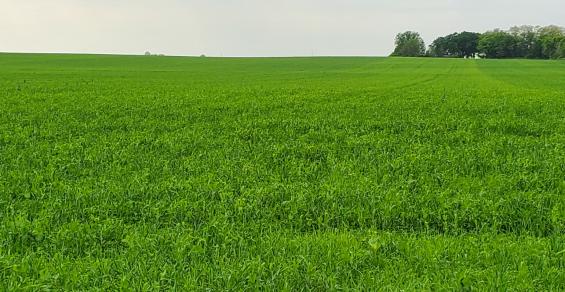Field Fodder: Use spring cereal crops such as oats, triticale or barley.
Cover crops are one tool farmers have to prevent soil erosion and nutrient runoff, improve soil structure, and suppress weeds. Planting cover crops after small grains or short-season crops is a great way to establish them. Here are key practices to keep in mind when deciding to plant a cover crop:
Use certified seed. This ensures a high germination rate and guarantees low or no weed seed presence. Bin-run seed may have variable germination rates, causing poor stands that may not meet your soil conservation or weed suppression goals. Do a germination test on bin-run seed to determine planting rate needed to establish the expected cover crop stand.
Be aware of restrictions from patented seed or the Plant Variety Protection Act when planting or purchasing bin-run seed. More information on the Plant Variety Protection Act can be found online.
Achieve good seed-to-soil contact. Just like cash crops, cover crops require adequate seed-to-soil contact to germinate. This can be accomplished through light tillage or a no-till planter set at the appropriate depth.
The germination rate of the cover crop seed will also be affected when soil moisture is low. Late-summer precipitation can be variable, and if soil is dry and there is no sign of rain in the near future, you will have to decide if planting the cover crop into dry soil has any benefit.
Consider a non-selective herbicide. This might be necessary to decrease any competition from emerged volunteer grain and weeds. However, there is potential for some herbicides to persist and impact the germination and growth of the cover crop.
The label lists a rotational restriction interval that defines the amount of time between the application and the establishment of the next crop needed to reduce potential injury. This may vary from a couple of days to 36 months or more. If the cover crop will not be harvested, then the crop can be legally established after herbicide application regardless of how much time has passed, with knowledge that the stand may fail due to possible herbicide carryover.
Restrictions must be followed for forages. If you’re planning on using the cover crop as a potential source of forage, then the rotational restriction interval must be followed to legally be used as feed. Several herbicides do not list a rotational restriction interval for cover crops to be used as mechanically harvested or grazed forage. If this is the case, then the maximum rotation interval listed on the label must be followed.
A list of rotational restriction intervals was compiled by the University of Wisconsin-Madison Nutrient and Pest Management Program. Always read and follow labeled directions when using all pesticides.
Use spring cereal grains. Grains such as oats, spring barley and triticale will grow rapidly in late summer and are low cost for soil cover. If used for a fall forage, these cereal grains will yield 1 to 3 dry matter tons per acre. Drill 1 to 2 inches deep, ideally by Aug. 1, for the best stand establishment.
Plant cereals at 50 to 60 pounds per acre. Increase the population to 85 to 100 pounds per acre if you will potentially use cereals as a forage. Winter cereal grains can yield about 1 ton of dry matter per acre if planted before mid-September. Target planting date is before Sept. 15 north of Highway 10 or before Oct. 1 south of Highway 10. Planting rates and depth are similar to spring cereals.
Due to the potential of brassicas loosening the soil with their large taproots and low residue left behind, it is recommended to plant a mixture of brassicas, such as Daikon radish, turnips, or rapeseed, with a grass. Plant 1 to 2 pounds per acre of brassica with 20 to 30 pounds of cereal grass one-quarter to one-half inch deep. A legume such as 6 pounds of berseem clover or 25 pounds of field peas can be added to the mix to provide more diversity to the stand.
Additional information on planning which cover crops to establish after small grains or short-season crops from the UW Nutrient and Pest Management Program can be found here: cover crop recommendations and cover crop options.
For a copy of these publications or additional information on cover crops, contact your local Extension agriculture educator or regional nutrient and pest management outreach specialist.
Marzu is the north-central region nutrient and pest management Extension outreach specialist with University of Wisconsin-Extension.



